Commercial Electronic Waste Recycling
Save on commercial electronic waste recycling quotes today
Just enter your business postcode…
Save on commercial electronic waste recycling quotes today
Just enter your business postcode…
Start saving now
⚠️ Welsh Businesses: Starting April 6 2024, new regulations require the separate collection of “unsold small waste electrical and electronic equipment (sWEEE)”.
Waste Electrical and Electronic Equipment (WEEE) represents the fastest-growing waste stream globally and in the UK, with most companies generating some level of e-waste. The UK ranked second in the world for electronic waste generation per capita in 2022, with each person producing a whopping 23.9 kg of e-waste.
Contents
Electronic waste, also known as ‘e-waste’ or more accurately as ‘WEEE’ (Waste Electrical and Electronic Equipment), essentially consists of discarded electrical or electronic devices and appliances.
This encompasses a broad spectrum of products used by UK businesses, from large appliances like refrigerators and air conditioners to smaller items such as computers, printers, smartphones, and batteries.
Since e-waste contains both various hazardous substances as well as recoverable valuable metals and potentially sensitive business data, UK regulations require that it is collected and disposed of separately.
The definition and classification of what constitutes electronic waste (e-waste) are governed by the Waste Electrical and Electronic Equipment (WEEE) Regulations that define 14 broad categories.
The waste devices and appliances in each of these categories has similar:
This makes the separation of e-waste by categories essential for safety and recycling efficiency.
💡 Stand-alone batteries are technically NOT considered WEEE despite having electronic and electrical components because their management is ruled by a separate set of regulations.2
Source: 1The Waste Electrical and Electronic Equipment Regulations 2013, 2The Waste Batteries and Accumulators Regulations 2019
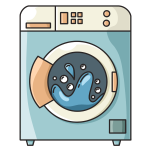
Fridges, cookers, microwaves, washing machines, and dishwashers.

Vacuum cleaners, irons, toasters, and clocks.
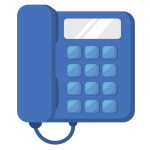
PCs, photocopiers, telephones, and pocket calculators.

Radios, televisions, stereos, camcorders, and musical instruments.

Straight and compact fluorescent tubes and high-intensity discharge lamps.
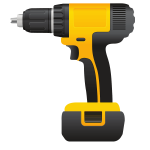
Drills, saws, sewing machines, and electric lawnmowers.

Electric trains, games consoles, and running machines.

Non-infected dialysis machines, analysers, medical freezers, and cardiology equipment.
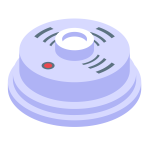
Smoke detectors, thermostats, and heating regulators.
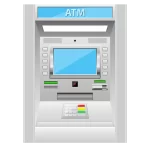
Hot drinks dispensers, vending machines and ATMs.

Includes items like monitors and TVs.
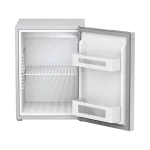
Such as refrigerators and air conditioners.
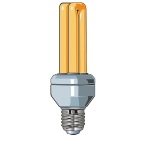
This category includes different types of lighting solutions.
Like any other recyclable waste stream, all UK businesses have a duty of care over their electronic waste. This primarily means that it:
✅ Must be collected and disposed of separately from other wastes.
✅ Must be collected and disposed of by a licensed waste collection provider.
✅ Must comply with WEEE and other specialised regulations.
✅ Must not be disposed of as household waste.
✅ Must not contain any sensitive data.
And finally, commercial waste management strategies must follow the waste hierarchy:
Businesses must first consider repairing any broken devices and appliances. This can often be facilitated through existing equipment warranties, insurance, or via a third-party service.
Many businesses frequently replace their existing fleets of perfectly functional equipment in order to remain competitive. Such equipment can be donated to entities like schools, non-profit organisations, or community groups.
Numerous companies now specialize in EEE refurbishments and are keen to trade in or purchase electronics, especially smartphones, tablets, and laptops.
A common practice among businesses is to have buy-back arrangements with their suppliers, where old equipment is exchanged for a discount on new purchases. This is especially prevalent in companies with lease agreements for their hardware.
If equipment is beyond repair or lacks demand, recycling becomes the final step prior to disposal. Businesses can organise either a one-off or regular commercial recycling collection.
Use the postcode finder below to request commercial waste quotes for your business today.
Disposal of EEE in the general waste stream is a last resort, only permissible after all ‘reasonable’ measures to repair, donate, trade-in, or recycle the equipment have been explored. This is particularly relevant for older EEE not suited to modern recycling techniques (although these tend to have hazardous components that must be treated as hazardous waste.)
E-waste is a typical example of hard-to-recycle items for business.
While there’s no specific mandate to categorise e-waste into each of the 14 WEEE categories, the ability of businesses to fulfil their e-waste duty of care largely depends on the policies and enforcement by local authorities and through devolved regulations.
Source: UK Gov – Guidance – Regulations: WEEE,The Waste Electrical and Electronic Equipment Regulations 2013,
WEEE regulations add extra responsibilities for UK and foreign businesses that:
Electrical and electronic equipment (EEE) in the UK. Their obligations depend on whether they are a “producer” or “distributor”:
“Small” producers handling <5 tonnes of EEE in a compliance year must simply register with the regulator, while “large” producers handling >5 tonnes must join a special Producer Compliance Scheme (PCS) and help:
Distributors must:
Distributors that sell less than £100,000 of EEE per year can join the Distributor Takeback Scheme.
For more comprehensive information on all additional obligations for producers and retailers, refer to the official guidance1.
Source: UK Gov – Guidance – Regulations: WEEE,The Waste Electrical and Electronic Equipment Regulations 2013
WEEE regulations do not prescribe specific symbols or colours for e-waste commercial bins. However, businesses commonly adopt the use of such bins to ensure compliance with the regulations’ requirements for separate collection and disposal of e-waste.
Source: The Waste Electrical and Electronic Equipment Regulations 2013
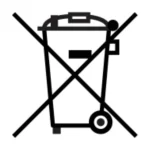 Crossed-out wheelie bin symbol
Crossed-out wheelie bin symbolSymbols: Electronic waste bins are usually identified by the universally recognised ‘crossed-out wheeled bin’ symbol. They are often labelled as ‘e-waste’ or ‘WEEE’ to further clarify their purpose.
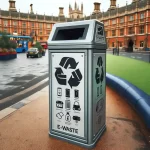 Gray-coloured e-waste bin
Gray-coloured e-waste binColour: Generally coloured distinctly to other bins, often in blue, green or gray. It is sometimes equipped with specific compartments or slots for different types of e-waste, like batteries, small electronics, or cables.
UK households and businesses generate over 1.6 million tonnes of e-waste annually, of which:
💡 Hoarding: Around 20% of electronic devices in the UK are hoarded or stored. This isn’t as harmful as outright disposal, but it prevents its reuse through donations or trade-ins.
The UK government’s zero e-waste to landfill by 2030 target seems achievable given the above statistics, at least in constituencies with high recycling rates and progressive devolved waste policies.
Sources: UK Gov – Statistics on Waste 2021, UK WEEE statistics 2023
Once all the electronic and electrical equipment (EEE) in your business has reached the end of its life (and can’t be reused, repaired, donated or traded in), it is collected by a licensed commercial waste collection provider and taken to
Sorting and Dismantling: E-waste is sorted into each of the 14 categories and dismantled. This step separates components, including those containing valuable metals and those containing hazardous materials.
Shredding and Separation: The separated e-waste components are shredded into smaller pieces. Advanced separation technologies are used to recover various materials like metals and plastics.
Material Recovery: Recovered materials are sent to be recycled into new products or disposed of safely if they can’t be recycled.
E-waste is a rich source of various valuable materials, including:
E-waste can contain a variety of hazardous substances, including:
All sectors of the UK produce e-waste, but the following are more notable:
IT and Telecommunications: This sector is a major contributor, given the rapid turnover of computers, servers, and communication devices.
Hospitals: Medical equipment like scanners, monitors, and diagnostic devices often contain advanced electronics that eventually become e-waste.
Offices: Offices regularly update equipment like printers, copiers, and fax machines, contributing to e-waste.
Industrial Electronics: Includes specialised equipment used in manufacturing and other industrial applications.
Retail: Electronic Point of Sale (POS) systems and related electronics are regularly updated, leading to e-waste.
Education: Schools and universities frequently update their electronic equipment, including computers, projectors, and lab equipment.